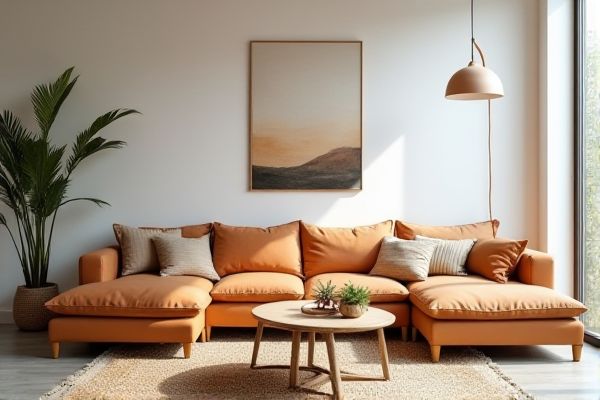
Minimalist decor emphasizes simplicity, clean lines, and a neutral color palette to create a serene, uncluttered space, while boho decor embraces vibrant colors, eclectic patterns, and natural elements for a cozy, artistic vibe. Explore the rest of the article to discover which style best suits your personality and living space.
Table of Comparison
| Feature | Minimalist Decor | Boho Decor |
|---|---|---|
| Style | Simple, clean lines, uncluttered | Eclectic, vibrant, layered |
| Color Palette | Neutral tones, whites, grays | Bold, rich hues, earth tones |
| Materials | Metal, glass, wood with smooth finishes | Natural fibers, wicker, rattan, wood |
| Furniture | Functional, sleek, minimal pieces | Mix of vintage, handmade, comfortable |
| Decor Elements | Minimal accessories, focus on space | Layered textiles, plants, art, patterns |
| Ambiance | Calm, orderly, spacious | Warm, cozy, inviting |
| Lighting | Natural light, simple fixtures | Warm, string lights, lamps |
| Target Audience | Lovers of simplicity and function | Creative, free-spirited individuals |
Introduction to Minimalist and Boho Decor
Minimalist decor emphasizes simplicity, clean lines, and a neutral color palette to create a calm and uncluttered space. Boho decor, in contrast, embraces vibrant colors, eclectic patterns, and a mix of textures to reflect a free-spirited and personalized aesthetic. Choosing between these styles depends on whether you prefer the streamlined elegance of minimalism or the layered, artistic vibe of boho.
Core Principles of Minimalist Decor
Minimalist decor emphasizes simplicity, functionality, and clean lines, prioritizing uncluttered spaces with a monochromatic or neutral color palette. Core principles include using only essential furniture and decor items, promoting open, airy environments that enhance light and space. Your living area benefits from this approach by fostering calmness and reducing distractions, creating a serene atmosphere.
Defining Characteristics of Boho Decor
Boho decor is characterized by a vibrant mix of colors, patterns, and textures that create a casual, eclectic, and globally inspired aesthetic. It often incorporates natural elements like woven fabrics, plants, and handcrafted accessories, emphasizing a relaxed and personalized atmosphere. Unlike minimalist decor's clean lines and neutral palette, boho design celebrates maximalism and cultural diversity through layered, curated collections.
Color Palettes: Minimalism vs. Bohemian
Minimalist decor embraces neutral, monochromatic color palettes dominated by whites, grays, and blacks, creating a clean and calming atmosphere. In contrast, bohemian decor features vibrant, eclectic mixtures of warm tones, jewel hues, and earthy colors, fostering an energetic and personalized space. Your choice between these styles will significantly influence the mood and visual impact of your living environment through its distinct color schemes.
Furniture and Material Choices
Minimalist decor emphasizes sleek, functional furniture with clean lines, often made from natural materials like wood, metal, and glass to create an uncluttered, serene environment. Boho decor favors eclectic, handcrafted furniture crafted from rattan, wicker, and distressed wood, featuring vibrant textiles and patterns that bring warmth and personality to your space. Your material choices will define the ambiance, with minimalism leaning toward simplicity and durability, while boho celebrates artistic expression and comfort.
Textures and Patterns in Each Style
Minimalist decor emphasizes smooth, sleek textures and subtle patterns, often featuring monochromatic or neutral color palettes that create a clean, uncluttered look. Boho decor embraces a rich mix of textures such as woven fabrics, macrame, and layered rugs, combined with vibrant patterns like tribal prints, florals, and geometric designs to evoke a warm, eclectic atmosphere. The tactile contrast between the two styles highlights minimalism's simplicity against boho's maximalist, textured complexity.
Accessorizing: Less vs. More
Minimalist decor emphasizes fewer, carefully chosen accessories that enhance clean lines and open spaces, promoting a sense of calm and simplicity. In contrast, boho decor embraces a rich variety of accessories, layering textures, patterns, and colors to create a vibrant, eclectic atmosphere. Your choice between minimalist and boho styles will determine whether you prioritize subtle sophistication or expressive abundance in your space.
Space Utilization and Layout Strategies
Minimalist decor emphasizes open spaces with clean lines and functional furniture, maximizing room for movement and avoiding clutter to create a serene environment. Boho decor utilizes layered textiles, eclectic furniture, and decorative objects, often filling spaces with vibrant, cozy arrangements that reflect personal style. Your choice between minimalist and boho affects layout strategies significantly, prioritizing either spacious simplicity or rich, intentional density in living areas.
Creating a Personalized Look
Minimalist decor emphasizes clean lines, neutral color palettes, and functional furniture to create a calm, uncluttered space that reflects simplicity and order. Boho decor embraces vibrant colors, eclectic patterns, and diverse textures, allowing for a more expressive and personalized environment that showcases individual creativity. Combining key elements from both styles can result in a uniquely tailored look that balances minimalism's tranquility with boho's artistic flair.
Choosing the Right Style for Your Home
Minimalist decor emphasizes clean lines, neutral colors, and uncluttered spaces, creating a calm and orderly environment ideal for those seeking simplicity and functionality. Boho decor features a rich mix of vibrant colors, eclectic patterns, and natural materials, appealing to individuals who prefer a free-spirited and personalized aesthetic. Selecting the right style depends on your lifestyle preferences and how you want your home to reflect your personality and comfort.
 homyna.com
homyna.com